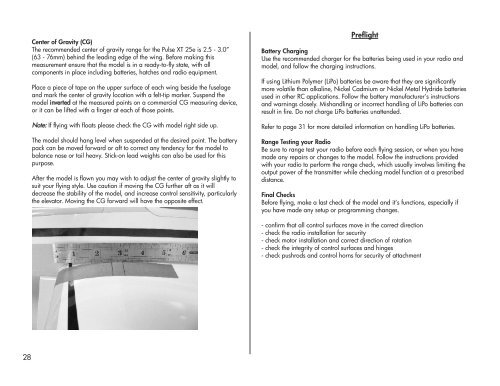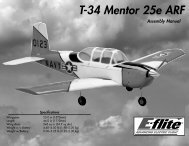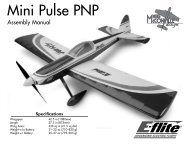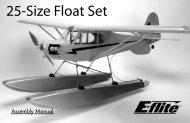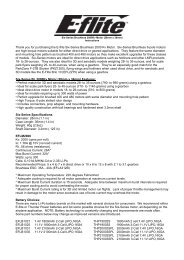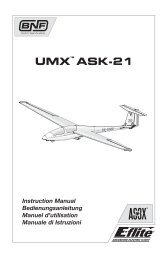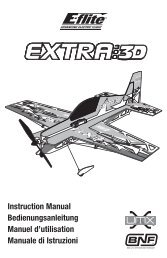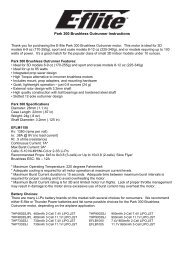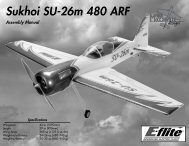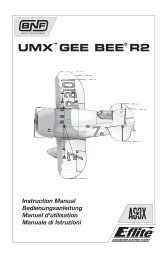Pulse XT 25e Manual - E-flite
Pulse XT 25e Manual - E-flite
Pulse XT 25e Manual - E-flite
- No tags were found...
Create successful ePaper yourself
Turn your PDF publications into a flip-book with our unique Google optimized e-Paper software.
Center of Gravity (CG)The recommended center of gravity range for the <strong>Pulse</strong> <strong>XT</strong> <strong>25e</strong> is 2.5 - 3.0”(63 - 76mm) behind the leading edge of the wing. Before making thismeasurement ensure that the model is in a ready-to-fly state, with allcomponents in place including batteries, hatches and radio equipment.Place a piece of tape on the upper surface of each wing beside the fuselageand mark the center of gravity location with a felt-tip marker. Suspend themodel inverted at the measured points on a commercial CG measuring device,or it can be lifted with a finger at each of those points.Note: If flying with floats please check the CG with model right side up.The model should hang level when suspended at the desired point. The batterypack can be moved forward or aft to correct any tendency for the model tobalance nose or tail heavy. Stick-on lead weights can also be used for thispurpose.After the model is flown you may wish to adjust the center of gravity slightly tosuit your flying style. Use caution if moving the CG further aft as it willdecrease the stability of the model, and increase control sensitivity, particularlythe elevator. Moving the CG forward will have the opposite effect.PreflightBattery ChargingUse the recommended charger for the batteries being used in your radio andmodel, and follow the charging instructions.If using Lithium Polymer (LiPo) batteries be aware that they are significantlymore volatile than alkaline, Nickel Cadmium or Nickel Metal Hydride batteriesused in other RC applications. Follow the battery manufacturer’s instructionsand warnings closely. Mishandling or incorrect handling of LiPo batteries canresult in fire. Do not charge LiPo batteries unattended.Refer to page 31 for more detailed information on handling LiPo batteries.Range Testing your RadioBe sure to range test your radio before each flying session, or when you havemade any repairs or changes to the model. Follow the instructions providedwith your radio to perform the range check, which usually involves limiting theoutput power of the transmitter while checking model function at a prescribeddistance.Final ChecksBefore flying, make a last check of the model and it’s functions, especially ifyou have made any setup or programming changes.- confirm that all control surfaces move in the correct direction- check the radio installation for security- check motor installation and correct direction of rotation- check the integrity of control surfaces and hinges- check pushrods and control horns for security of attachment28


